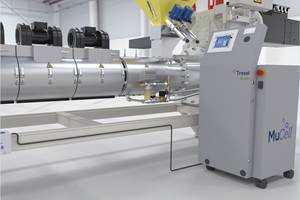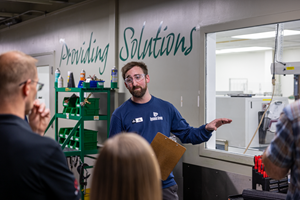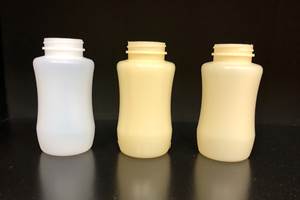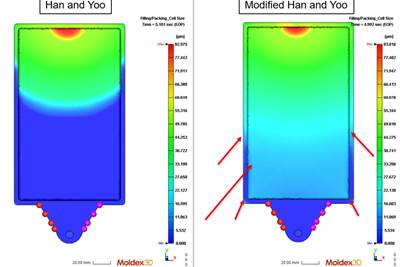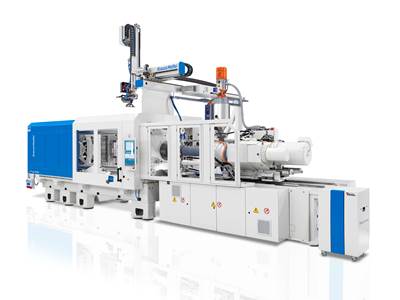Injection Foaming Tech Reduces Density, Increases Mechanical Properties
Based on an additive package custom-tailored to the application, Moxietec’s foaming technology promises stronger parts through consistent bubbles.
Conceived as a means to make a better hunting decoy, Moxietec’s injection molding foaming technology is pushing into everything from electric vehicles and construction materials to furniture based on the mechanical properties its uniform cell structure imparts.
Over many years working in the field as a recognized expert, Abolfazl Mohebbi came to many realizations about foam and plastics, two of which greatly inform his work in his current role at Moxietec LLC, Grove City, Pennsylvania. The first is that a foaming technology will only be as successful as it is operator friendly. The second: Managing every stage of foaming is key to consistent bubble structures, which also are key to consistent parts.

Moxietec’s technology tightly controls the foam structure within a part, boosting its mechanical properties. Source: Moxietec
“I’ve worked in all types of foaming technology,” Mohebbi says, “and you need a high level of skill to deal with those kinds of things. So, when you develop something and hand it to an operator who doesn’t have that technical background, most of the time, the project’s going to fail, or it’s not going to last very long.”
In all plastics-foaming processes, there are four main stages: gas saturation, nucleation, growth and stabilization.
In all plastics-foaming processes, there are four main stages: gas saturation, where gas molecules dissolve into the molten polymer; nucleation, in which nuclei are generated within the polymer matrix; growth, wherein cell growth and the creation of the cellular structure occur; and stabilization, where the resulting cellular structure cools and solidifies.
“What we do differently than everyone else,” Mohebbi says, “is we try to manage every stage more precisely. If you don’t have successful saturation and nucleation, you cannot grow the bubbles. You need to have a proper seed to grow them uniformly.” As a result of this micromanagement, Moxietec says it can control the average cell size and density, as well as cell-wall thickness, in its foamed parts.
Since joining Moxietec in 2021, Mohebbi has been committed to the company mission of creating an accessible process with maximal control of the foaming. “We have focused more on not just developing something that produces a good result but also developing something that creates a robust, more user-friendly process. All that matters is how you control the different stages.”
Decoy Dynasty
After winning a patent for a foaming technology that enabled large density reductions in injection molded polyolefin parts with a standard press, Moxietec began operations in 2017 when its creators spun the company off from its primary 911▒¼┴¤═° creating hunting decoys. Those founders are no longer involved. Mohebbi, who was hired as chief technology officer, set about locking down existing intellectual property and securing new patents around the foaming process. At press time, Moxietec holds 52 issued and pending patents in 24 different countries.

Part of Moxietec’s intellectual property for the foaming technology is its patented shutoff nozzle, which prevents the creation of cold slugs between shots. Source: Moxietec
As part of its operator-friendly process concept, Moxietec says it can deliver a true turnkey package for customers. This all-in offering includes customized material and additive package, based on application, part design assistance, mold design/construction, process development and a specialized patented shutoff nozzle. The nozzle, which has two patents granted, including one this spring, prevents the creation of a cold slug, which can mar part appearance.
To support all these capabilities, Moxietec’s 50,000-square-foot facility is fully equipped. For material development, the company has a 27-mm Leistritz twin-screw compounding extruder. For mold trials and process development, it has six Engel injection molding machines, ranging from an 85-ton E-mac to a 1,000-ton Duo, as well as a dual-barrel 560-ton Duo with rotary platen for multishot applications. Its lab offers mechanical testing; thermal analysis and rheology; microscopy and accelerated weathering. In terms of metal cutting, its machining capabilities include a behemoth DMG Mori DMU 340 Gantry 5-axis machining center.
“We try to have everything under one roof,” Mohebbi says. “For customers, we can start from scratch with formulation development, design, machining, everything.” The company’s plaque mold system, which is part of the formulation process, is protected by one of its patents. The product development molds have four interchangeable cavities and can be used to evaluate the foam structures and resulting mechanical properties of different material/additive mixes, with thicknesses of 3.2, 7, 14 and 25.4 mm, for potential weight reductions ranging from 20-65%.
“We pick one that is closest to what the customers want,” Mohebbi says, “and then we can run all the formulations quickly.” After plaques are molded, testing dog bones can be cut as needed. “We do all the mechanical property testing quickly because we don’t need to build a tool. We already have this prototype.”

Moxietec’s facility includes injection molding and machining capabilities in service of foamed part development. Source: Moxietec
The company has two commercial material grades available for polyolefins — MXTA 101 and MXTA 102 — with ongoing purchase orders sending material into the field. The company is also collaborating with material producer Invista on grades for nylon. Currently for nylon 66, it has grades providing a 34% density reduction with an average cell size of 280 µm and 46% density reduction with an average cell size of 245 µm. Moxietec has done additional development work with TPUs, PC/ABS and PVC, among other resins.
Finely Tuned Foam
During that postdoctoral research, Mohebbi says clients sought very specific mechanical properties, which forced him to develop fine-tuned formulations. That is in line with what Moxietec is currently offering its customers, weighing weight reduction against what the foamed molded product will be asked to do in the field. “Lightweighting is obviously important — everybody loves that — but everyone knows that you get to a certain point and the question becomes, ‘How does it affect the mechanical properties?’’’

At PTXPO, Moxietec partnered with Engel to demonstrate the foaming technology in action.
Source: Plastics Technology
Another key question is what impact will foaming have on the surface appearance, especially since there are foaming technologies that create bubble-free surfaces. Mohebbi says realistically there will always be some bubbles escaping to the surface if the foaming results in high density reductions.
“Whenever you’re dealing with foaming for any kind of structure, when you hit a high level of density reduction, there are always, always some bubbles escaping to the surface — always,” Mohebbi says. “When you’re talking about 30-40% density reduction, it doesn't matter what technology is used. You're bringing very powerful gas molecules into the melt and eventually they might escape to the surface.”
“You want to have repeatable, controlled mechanical properties, which means, first, you have to control the structure.”
For Moxietec, the proof is in the parts. Mohebbi shares video of one customer dropping a Moxietec-foamed square component, roughly 3 inches thick and 2 feet square, from chest height in sub-zero temperatures, with the part simply bouncing. At the recent PTXPO, organized by Plastics Technology parent company Gardner Business Media, Moxietec partnered with Engel to display the technology running live on a press. Among the example parts it brought was a chair’s´╗┐ seat component, which had a virtual Class A finish, despite 20% weight reduction.
“We can definitely get a high-quality surface with a high level of density reduction,” Mohebbi says, “but the higher you go, the more risk you will take. You want to control it in a way that you get that level of high-impact strength. You want to have repeatable, controlled mechanical properties, which means, first, you have to control the structure.”

Moxietec uses its extensive material testing and characterization lab to develop its tailored foam products. Source: Moxietec
Related Content
BMW Group Vehicle to Adopt 3D Printed Center Console
A vehicle coming to market in 2027 will include a center console carrier manufactured through polymer robot-based large-format additive manufacturing (LFAM).
Read MoreFoam-Core Multilayer Blow Molding: How It’s Done
Learn here how to take advantage of new lightweighting and recycle utilization opportunities in consumer packaging, thanks to a collaboration of leaders in microcellular foaming and multilayer head design.
Read MoreMedical Molder, Moldmaker Embraces Continuous Improvement
True to the adjective in its name, Dynamic Group has been characterized by constant change, activity and progress over its nearly five decades as a medical molder and moldmaker.
Read MoreHow to Extrusion Blow Mold PHA/PLA Blends
You need to pay attention to the inherent characteristics of biopolymers PHA/PLA materials when setting process parameters to realize better and more consistent outcomes.
Read MoreRead Next
Foam Molding Simulation Gains Better Bubble-Shrinkage Prediction
Microcellular foam molding simulation improves prediction of cell size and distribution in thin sections, core-back processes.
Read MoreMicrocellular Foaming Paired With Specialized Screw, Process Control Program
KraussMaffei will apply its APCplus dynamic process control technology and an optimized screw with the MuCell process in Friedrichshafen.
Read MoreNew Process & Material Permits Big Weight Savings on Foamed Parts
New firm develops technology that offers weight reductions up to 65% for large injection molded polyolefin parts.
Read More







